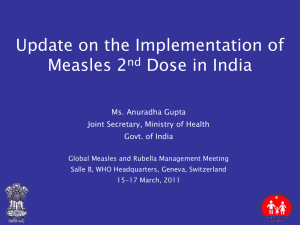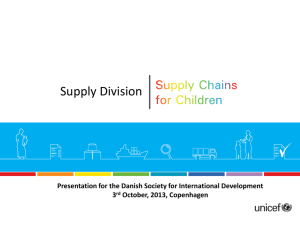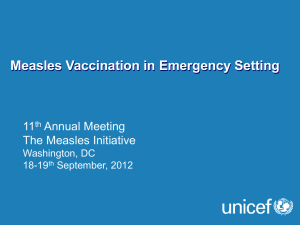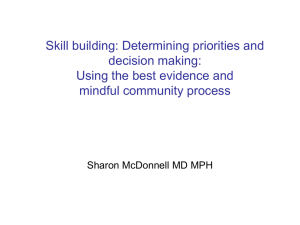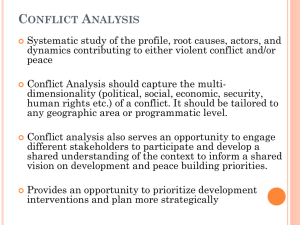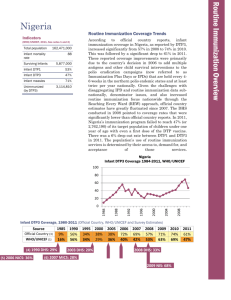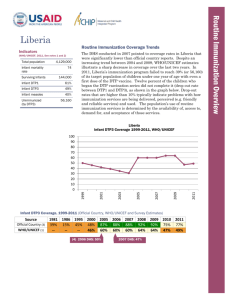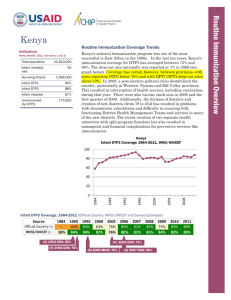Routine Immunization: The Fifth Child Perspective
advertisement
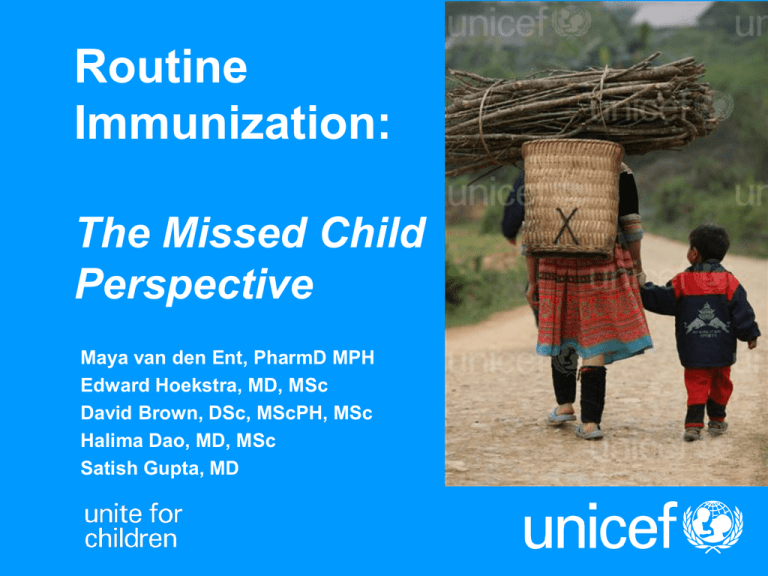
Routine Immunization: The Missed Child Perspective Maya van den Ent, PharmD MPH Edward Hoekstra, MD, MSc David Brown, DSc, MScPH, MSc Halima Dao, MD, MSc Satish Gupta, MD Coverage MCV1 globally and in 47 priority countries 100 85 80 72 78 60 58 40 20 0 2000 2001 2002 2003 2004 2005 2006 2007 2008 UNICEF Coverage Measles 1 st dose Source: WHO/UNICEF immunization coverage for 2010 Global 2009 2010 MCV1 Coverage 2000 – 2010 47 Priority Countries 2000 2005 Number of countries (all countries) MCV1 coverage 2010UNICEF Source: WHO/UNICEF immunization coverage for 2010 2000 2005 2010 <70% 37 36 26 70-79% 27 17 17 80-89% 44 31 24 90-99% 84 109 127 Human Rights The Universal Declaration of Human Rights: based on the principle of human equality; • everyone has right to equal access to public services in his or her country • everyone has the right to a standard of living adequate for the health and well being of him/her and family, including food, clothing, housing, medical care and social services. Child Rights…. Convention on the Rights of the Child: four core principles: • non-discrimination • devotion to the best interests of the child • the right to life, survival and development • respect for the views of the child. The poorest are more likely to die Indonesia Under 5 Mortality Rate by Wealth Quintiles 2002 - 2003 Level of under - nutrition in children belonging to the poorest households has remained stagnant for decade Proportion of children under 5 years who are underweight, by household wealth quintile Progress for Children: Achieving the MDGs with Equity ; September 2010; NFHS-2005-06 Every seventh child not reached 19.1 million infants not having received MCV1, 2010 India 35% others 35% Country United States of America 2% South Africa 2% Afghanistan 2% Ethiopia 2% Indonesia 3% Nigeria 9% Pakistan Uganda 3% 3% DR Congo 4% Cover age # Infants no MCV1 (routine) India 74 6,709,000 Nigeria 71 1,668,000 DR Congo 68 815,000 Uganda 55 630,000 Pakistan 86 619,000 Indonesia 89 468,000 Ethiopia 81 463,000 Afghanistan 62 458,000 South Africa 65 352,000 USA 92 342,000 Reasons for under- or un-vaccination Under – vaccinated Unvaccinated 21% 27% 28% Family Characteristics Parental Immunization System 7% Immunization Systems 44% % based on 887 reasons abstracted from 209 relevant articles Family Characteristics Attitudes 55% Communication and Information And Knowledge Parental Attitudes and Knowledge 12% 6% % based on 33 reasons abstracted from 12 articles on unvaccinated children Under vaccinated: Infants received at least one vaccine, but no DTP3 Un-vaccinated: Infants received no vaccine at all India: Immunization coverage varies significantly among different population categories Percentage of children age 12-23 fully immunized 73 37 63 63 53 50 46 36 Urban Rural Others Scheduled Scheduled Castes Tribes District Level Household Survey 2007-2008 Richest Qunitle Poorest Quintile India: Where are the unvaccinated? Children not vaccinated with DPT3 Source: DLHS 2007-08; children surveyed were between 12-23 months India: Where are the unvaccinated ? District - level percentage of fully immunized children Data not available FI (DLHS-2) Below 30 30 to 50 50 to 70 70 to 90 Above 90 Data not available FI (DLHS-2) Below 30 30 to 50 50 to 70 70 to 90 Above 90 Wide intra-state variations Source: DLHS 2007-08; children surveyed were between 12-23 months India – Predictors Only at least one vaccine vs fully immunized Poor Education Mother no TT2+ Minority religion Rural No Radio/TV Poor UNICEF Source: Swiss Tropical Institute 2010 The poorest are more likely not to be immunized DR Congo Disparities in Vaccination Coverage Measles (MCV1) Province DTP3 Province BCG Province Measles (MCV1) Rural vs Urban DTP3 Rural vs Urban BCG Between lowest Provincial and highest Provincial coverage Between rural and urban coverage Rural vs Urban Greater disparities between provinces than rural urban 0 10 20 30 40 50 Coverage Rate (%) Source: MICS 2010 60 70 80 Lowest 90 100 Highest How to Reach the Under-served Possible links between SIAs and RI - Measles Partnership explores ways to further strengthen routine immunization in 2012 - Plan for critical activities strengthening routine during SIA planning UNICEF Possible links between SIAs and RI Coordination & accountability for results Bottom-up Micro-planning Training Logistics Management • Cold chain assessment & maintenance Advocacy and Social Mobilization • • • UNICEF Evidence based Use of community health workers (defaulter tracing) Health education for caregivers Possible links between SIAs and RI AEFI monitoring and management Surveillance Monitoring and Evaluation • • • • UNICEF Supportive supervision Monitoring charts Review meetings feeding into new microplans Rapid assessments Measles campaigns reach the poorest Nationwide Measles Vaccination Coverage by Wealth Quintile, Kenya, 2002 Source: Vijayaraghavan M, et al. Health Policy 2007, 83: 27-36 Source: Vijayaraghavan M, Health Policy 2006 Conclusions • MCV1 coverage has steadily improved from 2000 - 2010 • 19.1 million children remain unreached in 2010 • Focus on underserved populations will have highest impact
